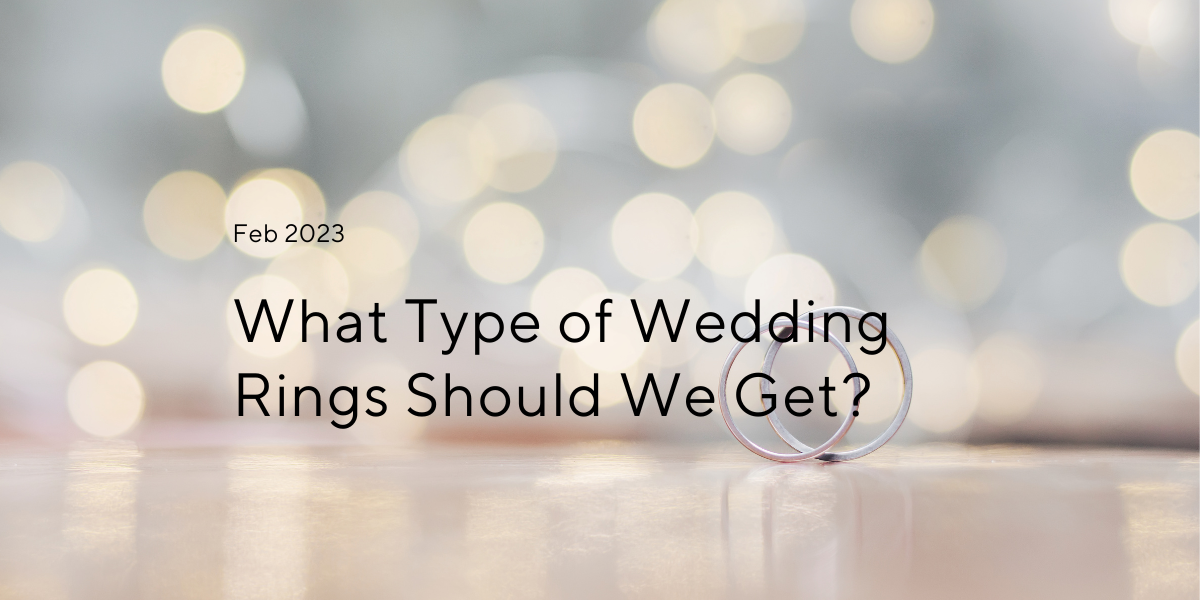Your wedding rings will act as a symbolic reminder of your commitment for the rest of your lives. You’ll wear them all day, every day, and have many conversations over the course of your lifetimes about the rings you chose and what they mean to you. Therefore, it’s essential to choose your wedding rings wisely. We’ve compiled everything you need to know to select the perfect rings for your budget, tastes, and lifestyle. We’ll take you through the pros and cons of different types of metal, other factors to consider, and how to care for your chosen rings.
Types of Metal
The type of metal you select has implications for cost, style/look, weight, feel, and durability. Get conversant about your options before making a decision.
Gold
Gold is luxurious, classy, and eye-catching. It’s also a reasonably affordable choice. However, it’s not always the most durable. High-karat gold is very soft, which means it succumbs easily to bending and scratches, and any jewels embedded in it can become dislodged and fall out easily. To mitigate this problem, gold is often mixed with other metals such as platinum, silver, or copper. 10-karat gold has a lower gold content but is very durable. Don’t go over 14 karats unless you’re willing to sacrifice the gold color for longevity. Nevertheless, all gold is prone to scratching.
Gold comes in a wide range of types. For gold wedding rings, your options are yellow gold, white gold, and rose gold. Each has its own unique characteristics, benefits, and drawbacks.
Pure gold is mixed with copper and zinc to create yellow gold, which has been used for millennia and remains one of the most popular and classic choices for wedding bands for both genders. It’s timeless, unlikely to go out of style, and is the most easily maintained among all types of gold bands. Although yellow gold is low maintenance, it does require regular polishing in order to keep its shine. It serves as an excellent choice, particularly for people with olive or darker skin tones, who can rock yellow gold like nobody’s business.
This particularly elegant shade of gold also contains nickel, silver, and palladium, giving it a unique white hue. Today, white gold is the most popular type of gold for both engagement and wedding rings. It is slightly more durable than yellow gold and looks especially handsome when paired with fair or rosy skin tones and/or colorless white diamonds. One disadvantage of white gold, though, is that it requires professional maintenance on its rhodium coating every few years. It also is not suitable for anyone whose skin is sensitive to nickel, which is a common allergen.
Rose gold is an alloy of copper, silver, and gold. The copper gives it a stunning pinkish, red, or rose-colored tint, imbuing it with a sense of romance when used in wedding bands. It is more durable than white or yellow gold but still less durable than harder metals. It also looks attractive on all skin tones. The main drawback of rose gold is that, like white gold, it has a high propensity for causing skin itching and irritation due to its copper content.
Platinum scores very high marks for strength. If you plan to include precious stones in your rings, opting for platinum is a surefire way to make sure those stones stay in place for the long haul, as it can handle far more wear and tear than other metals without becoming bent or scratched. It also retains its beautiful color and shine, which means it never needs to be re-plated. Any minor scratches or tarnishes it might suffer can be easily fixed by a jeweler.
Platinum is also one of the rarest metals–so much so that it was pulled from the jewelry market to conserve money for war efforts in World War I. Its scarcity today contributes to the perception of platinum as a high-end choice. As such, platinum rings are pricey.
Shiny, white-hued palladium looks similar to platinum, but it’s more affordable. It does lose a few points for durability, but in the grand scheme of rings, it’s still considered a durable metal. Palladium will keep its mirror finish even when worn daily by people with active lifestyles. It’s also lightweight and gets great reviews for comfort. However, scratches are going to show more than on platinum. It’s also difficult to resize palladium, which means that you might have to replace it if your fingers ever change size.
Silver is both elegant and affordable, making it a well-loved choice for wedding rings. However, silver is exceedingly soft and must be mixed with copper or other metals. Sterling silver is what’s created in the process. It boasts increased durability without sacrificing beauty or color.
Nevertheless, sterling silver requires some upkeep because it is still more pliable than other metals and will acquire scratches over time. It is also prone to tarnishing and requires regular polishing and cleaning. Don’t choose silver for the price; there are other metals at similar price points that are more durable. Choose sterling silver if you’re in love with the look and don’t mind a little bit of ring TLC.
Titanium is distinctive for its strength and is also surprisingly lightweight. If you are not accustomed to wearing jewelry on a day-to-day basis, a titanium wedding ring is a great choice because you won’t even notice it’s there and won’t be bothered by the feeling of extra weight on your ring finger. Stylistically, titanium has a classy, modern look to it and will integrate seamlessly with professional attire and accessories. It also does not scratch easily and doesn’t require maintenance. However, like palladium, titanium cannot be resized.
When it comes to durability and strength, tungsten is at the extreme end of both spectrums. It’s a whopping four times stronger than titanium, and it’s scratch-resistant and tarnish-resistant. Like titanium, it is hard enough that it doesn’t require maintenance. Best of all, it makes a surprisingly budget-friendly ring option.
There are downsides, of course. Tungsten is another metal that doesn’t lend itself well to resizing, so plan accordingly. It is also brittle and tends to fracture if dropped or knocked against a hard surface.
Make a Decision!
You’re going to see and try on infinite gorgeous ring options, each with its own set of pros and cons. Making a choice will be both difficult and high-stakes, so here are the most important considerations to factor into your decision.
Investigate Stylistic Touches
Aside from simply the type of metal you choose, there are plenty of features you can add to your rings. For example, many couples add custom engraving to the insides of their rings. Like this idea? Choose a quote that’s meaningful for your relationship, both of your initials side by side, or even a simple image.
Alternatively, many rings feature precious stones embedded in the band. If there’s a stone that you both love that suits both of your personal styles, choose a style with this stone incorporated or have one custom-made. Finally, some rings are intricately carved and feature designs of swirls, spirals, and lines of varying length and shape. Look around at different stylistic touches in order to determine whether you want a bare, simple band or something less minimalistic.
Consider Your Budget
About 3-5% of your wedding budget should be allocated to rings. Feel free to adjust that up or down if rings are particularly important (or not) to the two of you. Keep in mind that factors like style, design, ring setting, and choice of diamonds or other precious stones will influence the price of a ring beyond just what metal it is made from.
Wedding experts recommend choosing your rings early on in the wedding planning process. Doing so will free you up for wedding preparations that are more time-consuming and occur closer to the big day.
Choose Rings that Match Your Lifestyles
If you live an active lifestyle and/or work with your hands a lot, you’re going to want to choose something durable in order to avoid ruining or damaging your ring. Sit down and make a list of all the things you do with your hands that might affect a ring. Including things like cooking, making art, fixing things up around the house, and even typing.
Next, ask yourself how your preferred ring style would be negatively affected by these activities. For example, chefs should steer clear of engraved rings because spices and food particles can get stuck in the engraving. Anyone who types a lot is best off avoiding clunky, heavy rings with large stones that might get in the way. Sculptors or even anyone who does handy work that involves hammers and other hard objects are advised to choose durable rings that are not easily damaged by being knocked against hard surfaces.
Consider Maintenance
Either choose a ring that can be easily cleaned and maintained, or be ready to take on the task of caring for your ring on the reg. Keep in mind that engraved rings and rings with intricate designs can be quite a task to clean and shine, although some couples consider this a worthwhile trade-off in exchange for the symbolic meaning they derive from their rings. Dual-toned rings, as well as those with wood or ceramic inlays, are also complicated to maintain. Go for platinum, titanium, or tungsten if you don’t want to trouble yourselves with ring upkeep. Otherwise, make sure you identify a jeweler you trust with ring maintenance and read up on how to care for your rings at home.
How to Care for Your Wedding Rings
No matter what metal, style, and ring design you choose, assume that it will need occasional at-home TLC. Here’s what you can do to show your ring some love when necessary.
- When you notice a bit of buildup on your ring, soak it overnight in white vinegar or a solution of water and a little bit of dish soap. Alternatively, lightly scrub all around and under it with a baby toothbrush.
- Have jewelry-polishing cloths on hand at home. Polish as needed to maintain shine.
- Take your ring off before swimming, cleaning with harsh chemicals, doing yard work, doing intense exercise, or any other activity that could potentially damage or dirty it. If you’ve bought a super durable ring, this might not be necessary…but if in doubt, take it off!
- Have your ring serviced annually, no matter what it’s made of. It’s too special to take any chances on letting it degrade or diminish in beauty over time.
Final Thoughts
Consider all the factors we’ve explored above, and you will find the right rings for you and your relationship. Take your time, educate yourselves on your options, and mull over possibilities before making a decision. Ask your jeweler, wedding planner, and/or married friends and family members for help and insight if needed. Your wedding rings are a special symbol of your love and commitment; choose something you will treasure for years to come.
Now that you know how to select your rings, find out how to plan your wedding like a pro, check out fall wedding trends, or drool over beautiful places to elope. We hope your wedding will be the most beautiful day of your life yet.

Nicole Sheehey is the Head of Legal Content at HelloPrenup, and an Illinois licensed attorney. She has a wealth of knowledge and experience when it comes to prenuptial agreements. Nicole has Juris Doctor from John Marshall Law School. She has a deep understanding of the legal and financial implications of prenuptial agreements, and enjoys writing and collaborating with other attorneys on the nuances of the law. Nicole is passionate about helping couples locate the information they need when it comes to prenuptial agreements. You can reach Nicole here: [email protected]

0 Comments